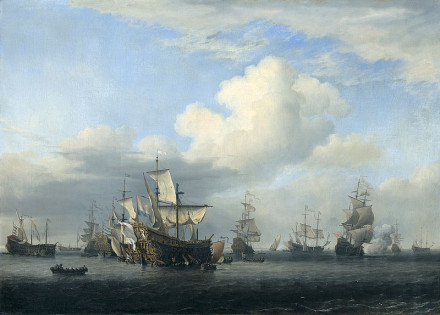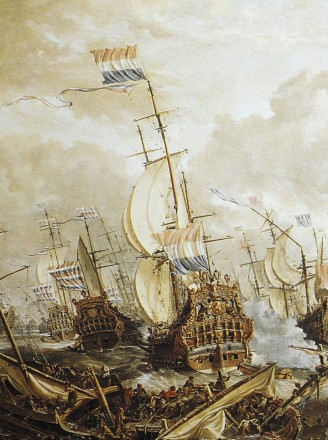History
Famous flagship
The Zeven Provinciën was built in 1664-65 for the Admiralty of de Maze in Rotterdam, by master shipbuilder Salomon Jansz van den Tempel. It's name means 'Seven Provinces', after the (then) seven provinces that made up the Republic of the Netherlands. It first functioned as the flagship of the famous admiral Michiel de Ruyter during the Second Anglo-Dutch war between 1664-1666.
It took part in the hard-fought Dutch victory in the Four Days' Battle, the bitter defeat at the St. James's Day Battle, and acted as a command post and aided in blockading the Thames during the Raid on the Medway. The vessel gave a good account of itself throughout the war, although it was partially dismasted during the Four Days' Battle. It also took part in the Battle of Solebay (1672), the Battles of Schooneveld (1673) and the Battle of Texel (1673). Several documents on the Ruyter's time on this ship, such as journals, can be found in the Dutch National Archives (see references).
Later years
De Ruyter took the ship across the Atlantic on an expedition to Martinique in 1674. After the death of de Ruyter, the ship became the flagship of rear admiral Jan van Brakel. After this, the ship still had a long fighting career. The last major battles in which it took part were the Battles of Barfleur and La Hogue during the War of the Grand Alliance. The vessel was severely damaged during the latter. Its (last) commander in this period was Evert de Lieffde, whose ship's journal from 1692 has been preserved. Finally, in 1694, the Zeven Provinciën was sold to be broken up.

The Four Days' Battle (11 to 14 June 1666)
This was one of the largest naval battles of the Second Anglo-Dutch War and in the age of sail, ending in a Dutch victory. The outcome is sometimes described as inconclusive, however, because both sides initially claimed victory. It was fought from 11 June to 14 June 1666 according to the Gregorian calendar (June 1st-4th according to the Julian calendar then in use in England) and it took place off the Flemisch and English coasts. The English fleet of 56 ships, commanded by George Monck, was outnumbered by the 84-strong Dutch fleet commanded by admiral Michiel de Ruyter. The Dutch inflicted significant damage on the English fleet.
The English had gambled that the crews of the many new Dutch ships of the line would not have been fully trained yet, but were deceived in their hopes: they lost ten ships, with slightly over 1.000 men killed including two vice admirals - Sir Christopher Myngs and Sir William Berkeley - while about 2.000 English were taken prisoner. The Dutch losses were four ships destroyed by fire and over 1.550 men killed, including lieutenant admiral Cornelis Evertsen, vice admiral Abraham van der Hulst and rear admiral Frederik Stachouwer.

Aftermath
Two months later the recuperated English fleet challenged the Dutch fleet again, now much more successfully in the St. James' Day Battle. Though this proved to be a partial victory, the Dutch fleet wasn't destroyed and the enormous costs of repair after both battles had depleted the English treasury, so the Four Days' Battle is usually seen as a minor tactical but important strategic victory for the Dutch fleet.

The captured Swiftsure, Seven Oaks, Loyal George and Convertine, Willem van de Velde the Younger, ca. 1666.
Description
It was the flag ship of several (rear) admirals: Michiel de Ruyter, Jan van Brakel and Johan Snellen. Its last master was Evert de Lieffde.

Detail of a painting on the Four Day's Battle by Ambraham Storck, 1666-1708, depicting the Zeven Provinciën. The painting is called 'The 'Royal Prince' and Other Vessels at the Four Days' Fight, 1-4 June 1666'.
Yard: old admiralty yard of Rotterdam
Crew : over 420
Armament: ca. 80 cannon
| Length | 163 Amsterdam feet (46.2 m) |
|---|---|
| Beam | 43 Amsterdam feet (12.2 m) |
| Displacement | 1600 ton (800 last) |
Status
In 1995 a start was made with the construction of a replica of the famous Zeven Provinciën at the Bataviawerf historical shipyard in Lelystad, the Nethertlands. The ship was chosen for this purpose since it is considered to be one of the most famous historical Dutch warships. The construction was ended in 2013 due to financial reasons.
References
- Video of the raid on Chattam.
- Marineschepen.nl.
De Zeven Provinciën. - Batavialand.nl.
De Zeven Provinciën. - Nationaal Archief.
Inventaris van het archief van Michiel Adriaensz de Ruyter.